
|

|
| Ferrari Enzo 6.0 V12 |
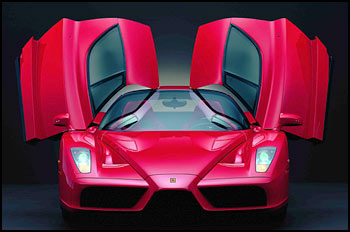
|
The Ferrari Enzo. The bare facts are these: 660bhp,
1,365kg, 217.5mph, 3.65sec to 62mph, £425,000 and a production run of 399 cars. Massively impressive numbers that surely make
the new Enzo the fastest, most accomplished road Ferrari ever, as well as the most expensive. Maranello's achievement is made
even more so because the Enzo has been homologated to be sold globally (though only in left-hand-drive) and therefore incorporates
the most comprehensive passive safety and emission controls ever seen on a supercar. Officially known as the Ferrari Enzo
Ferrari, Maranello realistically acknowledges that everybody will simply call the new supercar 'Enzo'. In virtually every
area this spiritual successor to the 288 GTO, F40 and F50 steps outside Ferrari's existing order.
| Ferrari Enzo 6.0 V12 |
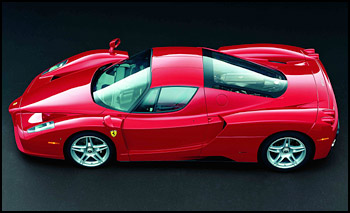
|
The Enzo - most commonly tagged F60 up until
now - pushes known road-car technology barriers and harnesses enough Formula One experience to go way beyond being merely
a celebration of Ferrari's world champion constructor triumphs over the past three years. Ferrari's president, Luca di Montezemolo,
claims that the Enzo brings together "everything we currently know" in one very special road car. "I wanted to go a little
bit too far in every element" says di Montezemolo. "The engine, the design, the performance, the doors, the areodynamics,
to build a super-extreme car. I wanted to go too far. It's easy to come back - I prefer to come back - instead of adding."
We knew the weak points of the F50, "The noise problems, the impression of a lack of performance from low revs. We set out
to use all of our experience to correct the mistakes of the previous car."
| Ferrari Enzo 6.0 V12 |
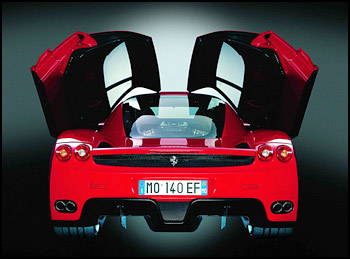
|
As always, Ferrari went to Pininfarina for the
styling, clearly defining it's areodynamic objectives and stipulating that this supercar would be a coupe only. The Enzo isn't
beautiful, but neither is it ugly. It looks intense, dramatic, mean and agressive. You can argue that the front, mirroring
F1 practice with it's raised nose splitting the side vents, is visually at odds with the softer, more curvaceous tail. Yet,
it is overwhelmingly a functional areodynamic statement. Ferrari are saying: "drawing on our F1 experience, our advanced understanding
of areo means that, unlike with the F50, we no longer need a huge rear wing for downforce." Some aspects of the styling are
controversial. There is already a debate over the validity of the upward curved line of the door windows. Some people really
like it, others hate the arc.
| Ferrari Enzo 6.0 V12 |
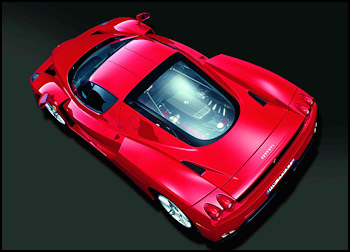
|
The styling works as a creator of downforce (Ferrari
prefers 'negative lift') so neccessary if the 200mph-plus Enzo is to be an effective road - and possibly race - car. The entire
underbody is tailored to the demands of the wind tunnel. Flaps ahead of the front wheels and below the radiators automatically
work in unison with the small adjustable rear spoiler to give a load of 344kg at 125mph, increasing to 775kg at 186mph. The
downforce then begins to ease to help raise the top speed to nearly 220mph, when it produces 585kg. Again, Ferrari has applied
it's F1 expertise to the development of a light and rigid composite chassis and body, using sandwich panels of carbonfibre
and aluminium honeycomb. To avoid the vibration and noise inherent in the F50 decision to bolt the V12 directly to the carbonfibre
tub, Ferrari developed a substantial tubular-steel subframe to support the mid-mounted engine and rear suspension, and another
up front, in the nose, incorporating deformation boxes to help the car pass the 35mph offset crash tests.
| Ferrari Enzo 6.0 V12 |
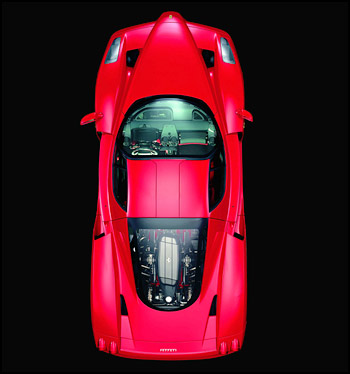
|
Concerned that Brembo might not be able to solve
the problems associated with mounting the preferred carbonfibre brakes on a road car, Ferrari insisted on a parallel development
programme for conventional discs, and didn't reach the decision to go with carbon until April 2002, just a few weeks
before the car had to be shown to the general public. Ferrari is now convinced that Brembo, which has developed a compound
known as carbon-ceramic material (CCM), has cracked the poor cold-temperature performance difficulty; as a result, the hugely
powerful brakes are a fully 12.5kg lighter than normal and totally resistant to fade. The CCM discs are 380mm in diameter,
34mm thick, with six-pot front and four-pot rear callipers. In imitation of it's F1 set-up, Ferrari has tuned the suspension
- push-rod double wishbones front and rear - around specifically developed Bridgestone tyres known as Potenza RE050A Scuderia.
Continuously variable dampers employ four sensors to maximise body control and comfort as required.
| Ferrari Enzo 6.0 V12 |
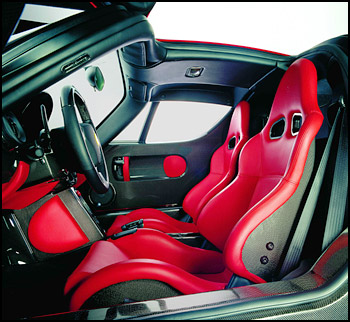
|
For the Enzo, Ferrari set about developing
a totally new, normally aspirated 65deg V12 that is set to form the basis of Ferrari's upcoming replacements for the 456GT
and 575M, and beyond. For the Enzo, it's 92mm bore and 75.2mm stroke that give a single-cylinder capacity of 499.8cc and a
total capacity of 5998cc, with a maximum engine speed of 8200rpm. The quad cams are belt driven, have continuously variable
inlet and exhaust timing and continuously variable inlet manifold to maximise torque output. Each bank of cylinders is controlled
by a Bosch Motronic ME7 engine management unit, and feed through a drive-by-wire throttle with a single coil for each spark
plug. The Ferrari punches out 650bhp at 7800rpm and a maximum torque of 485lb ft at 5500rpm on regular 95octane unleaded.
You can shift gears only one way in the Enzo - using Ferrari's clutchless F1 system of steering-column mounted, carbonfibre
paddles - right for up and left for down - shift speeds are down to a minimum of 0.150sec, compared with Ferrari's previous
best of 0.220sec for the 575M.
| Ferrari Enzo 6.0 V12 |

|
Apart from deeply bucketed leather seats and
a few leather patches, the interior of the Enzo is largely built of carbonfibre; dash, floor, doors. In such a simple, intimate
world don't expect to find a sound system. You will find air-conditioning, anti-lock, a digital trip computer and a steering
wheel designed to look like Schumacher's, down to having a row of five rev-warning lights across the flat top. They light
up progressively as the revs climb above 5500rpm, before flashing at 8000rpm. Six control buttons on the central spoke ensure
the wheel is the drivers control centre. Even the turn indicators are positioned in the upper spokes. Only the 10,000rpm rev
counter and 400km/h speedo are circular, the minor controls are analogue set in a panel to the left of the main dials. The
Enzo is undoubtedly Ferrari's most committed expression of it's huge F1 and road-car experience, and is seemingly free from
the compromises that limited the appeal of the F50. Ferrari GB expects to see just 24 or 25 examples over the cars two-year
production cycle. All are effectively sold, even at circa-£500,000. The Enzo has the potential to lift the mantle of
best-ever supercar from the Mclaren F1. A celebration of current F1 triumphs.
| Jaguar R-Coupe (Concept) |
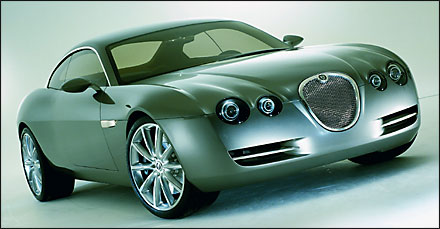
|
The new generation of Jaguars will look something
like this. It's the R-Coupe, a concept car whose design details, just like the F-Type, highlight the shape of things
to come for the company. From all angles, the R-Coupe looks great - Purposeful and muscular yet still retaining styling cues
from the past. This car is full of clues about the way the big cats of tomorrow will look. Making it's public debut at the
Frankfurt motorshow in October 2001, Jaguar's handsome concept car is a big, full four seater coupe around the size of
the S-type saloon. It's strictly for show but has been designed around the company's four-litre supercharged V8 engine.
| Jaguar R-Coupe (Concept) |
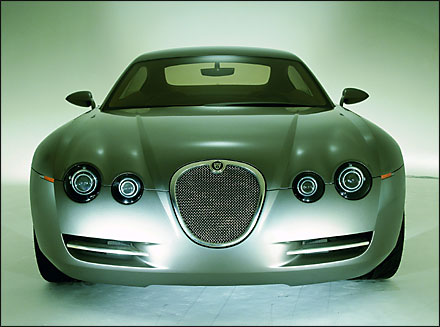
|
The R-Coupe is the first product of the men now
in charge of Jaguar's styling, following the death of Geoff Lawson who was responsible for the current range. His successor
as styling director is Ian Callum (Aston Martin DB7 and Vanquish, Volvo C70) and head of advanced design, where the R-Coupe
was divised, is Julian Thomson - the man behind the first Lotus Elise. It puts their styling stamp on Jaguar and is the
starting point for where Jaguar designs will now go. Expect to see some of detail ideas on the next production car, the new
XJ saloon, and many more finding their way into future models. What you won't see though, is a production version of this
concept car.
| Jaguar R-Coupe (Concept) |
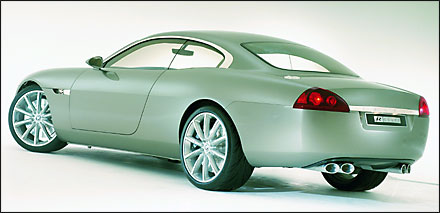
|
Jaguar deliberately chose a model that they would
not build to make it clear that this is simply a machine made up of ideas. The R-Coupe is a classically proportioned coupe
that gives obvious nods in the direction of past Jaguars. There are the heavily curved, aircraft-like flanks of the E-Type,
the flowing waistline with it's slight 'coke bottle' curve, the distinctive swoop of the roofline - seen in varying degrees
in every Jaguar for the past 40 years - and the camshell bonnet of the MkII and much more recently, the S-Type. The R-Coupe,
is at heart, a very modern design, it's to help everyone understand what Jaguar is all about. It looks like it's moving
when it's standing still. The four seats are covered in the softest grade connolly leather with the rear passengers getting
as much space as the front. The floor is also leather lined instead of the usual carpet you would expect to find. For the
insets, they settled on wood, but not just any old wood - rather an expensive ebony costing £20,000 a tree.
| Jaguar R-Coupe (Concept) |

|
Other new design features on the R-Coupe include
lights up front that turn with the direction of the steering, double-flapped fuel filler cap and Union Jack side vents. The
rear is unlike any Jaguar and the front has a very S-Type-like grille and the X-Type-derived lights look familiar. The multi
lens rear lights have a very 'pointed cats ear' look about them and they also use LED and halogen displays to give progressive
brake lighting. The sharply cut-off boot line, four machined aluminium exhaust outlets and massive tyres make it look a decidedly
mean machine. Those tyres sit on specially-crafted 21-inch alloy wheels milled out of solid lumps of aluminium and cost around
£5,000 a pop. The tyres are also a one-off, fat Continentals with a special 'cat's claw slash' tread pattern.
| Jaguar R-Coupe (Concept) |
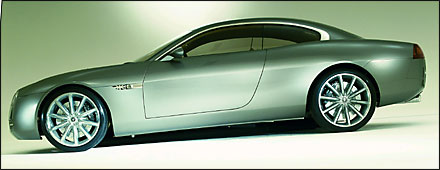
|
From the original sketch to finnished show car,
creating the Jaguar R-Coupe was a mammoth team effort. From start to finish, creating the R-Coupe show car has taken exactly
a year. The designers in Jaguar's advanced styling studio were first given the project in August 2000. Early sketch work was
created by four designers plus Thomson. Meanwhile, an engineering team was briefed to put together a realistic engine and
chassis package which the car would be designed around. With the engineering base of the car sorted, the designers got down
to what was, in effect, a competition to produce the winning design. They found the one they wanted, and began to build.
| Jaguar R-Coupe (Concept) |
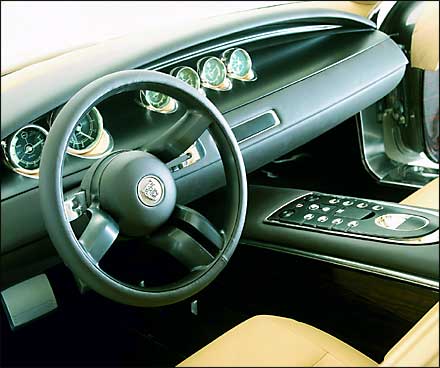
|
The R-Coupe looks great! I hope some of the styling
features do come into play on future models. This is the future for Jaguar, big, bold and out there with it all to play for.
It's all looking good now with a new team of designers that can really strike a nerve. The only reason people see the Jaguar
marque as an 'old mans car' is because they either can't afford one or they are too young to understand the brilliance of
the company. Besides, Jaguar have lost that image now with the new X-Type (The new Jag generation) I wish everyone involved
with the future of Jaguar good luck, from this, the F-Type and the X-Type, we know they are a great team and that they can
deliver.
| Ferrari 575M Maranello |
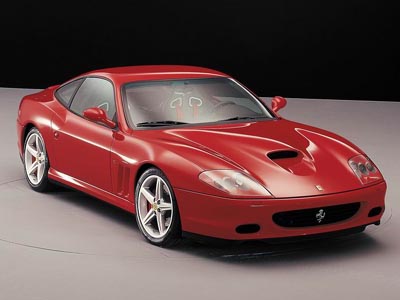
|
Ferrari's 550 Maranello was a revelation. A choir
of voices gloried in it's looks, it's performance and it's amazing 12-cylinder engine. Now Ferrari disciples can worship the
born-again version, the 575M Maranello, 'M' standing for 'modificata' - or modified, for those of you without a villa
in Tuscany. The V12 front engined 550 Maranello went to 199mph and had 485bhp. The 575M Maranello reaches 202mph and enjoys
515bhp. When launching off the line, the 550 Maranello would hit 62mph - or 100km/h - in 4.4sec. The 575M Maranello can do
it in 4.2. The 575M Maranello has computer controlled adaptive suspension, which, along with a subtly re-profiled nose,
now offers superior aerodynamics. Where the 550 Maranello had an engine displacement of 5474cc, the 575M Maranello has
5748cc, it's kind of a 'round up and divide by 10' thing. This was the first car that Ferrari decided to couple the V12
with the F1 Paddle-Shift gear change with, the second was the V12 Enzo.
| Ferrari 575M Maranello |

|
However, it is not the first time that an F1-Shift system
has been coupled to a V12 engine in any other car, Aston Martin V12 Vanquish, anyone? The 575M Maranello uses
255/35 tyres on the front and 305/30 on the back, it also has ASR traction control on board that you can use to do Launch
Control. Turn it off, press the brake, press the right paddle (Up - First) dial up some revs with the throttle and let go
of the brake! Your off, towards the horizon, a court-case and a ban! Because the F1-System minimises the time spent between
ratios, the car can sprint to 62mph in a full five-hundreths of a second quicker than a manual. Wheather this is worth the
extra £6,495 over the price of a £154,350 manual 575M Maranello is up to you. The 575M Maranello still looks amazing,
the headlamps, front spoiler and air intakes have been carefully rejigged and I'm a fool for anything designed by Pininfarina!
| Ferrari 575M Maranello |

|
For the Ferrari 575M Maranello, if you want to
fork out some extra cash, then you can for the Fiorano handling pack of uprated suspension and brakes, plus some carbonfibre
interior trim and racing seats, Ferrari will be pleased to accomodate. The F1-Transmission belongs on the track, town and
motorway driving using the F1-System is a nightmare and does not do the car or gearbox much good. At least on the track, it
means that if you find yourself going too fast mid-bend, you can shift down ultra-quick, use the engine braking and keep
the car stable. Plus both of your hands are on the wheel! The 550 Maranello was a trailblazer. The 575M Maranello takes up
the batton and runs a little further and a little faster with it. The 575M Maranello, especially with it's trick F1-Shift
system, is an incredible piece of machinery. For sure.
| Ferrari 575M Maranello |
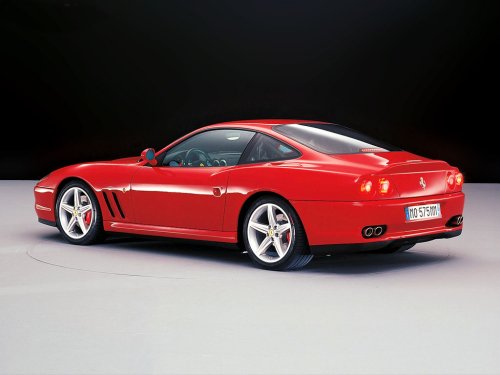
|
Ferrari 575M Maranello
Performance:
0-62mph in 4.2sec
-
202mph top speed
Engine:
5748cc 48-valve V12
Max power:
515bhp @ 7,250rpm
Max torque:
434lb ft @ 5,250rpm
Power to weight ratio:
291bhp per tonne
Transmission:
6-speed paddle shift manual (with auto mode)
rwd
Brakes:
Brembo, ventilated steel discs 330mm (front)
310mm (rear)
Kerb Weight:
1,745kg
Price:
£160,845 (F1 Auto)
|

|

|

|

|
| Ferrari 360 Modena Spider 3.6 V8 |
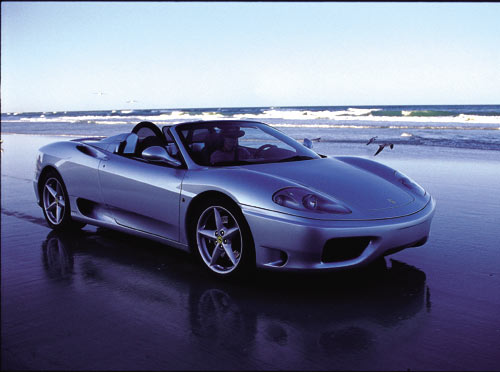
|
The Ferrari 360 Spider is Ferrari's 20th road-going convertible and is a record breaker in two quite
different ways. Without doubt it is the best spider Maranello has ever produced in terms of engineering, looks and performance.
And, thanks to the exclusive experience Ferrari has accumulated as a Formula 1 constructor, it is the most technologically
advanced convertible available today. Despite the ferrari's mid-mounted V8 engine Ferrari's engineers
have found a way of creating a hood that automatically folds away inside the engine bay, thus ensuring purity of line. The
intrinsic quality of the design is underlined by the two fairings in the bodywork to the rear of the seats which evoke memories
of classic ferrari sports cars. These are matched by the two roll bars that add the final touch
to providing maximum safety for the car's two occupants. But the above car is not just a car, it's a Ferrari,
a Ferrari 360 Modena Spider. This, being a Ferrari is a very special car. The world should celebrate such creations of glory,
a celebration of speed, power, poise and noise. This car has a heart and a soul, a mind and a spirit, it lives, breathes and
exists in a world of glamour and money. This car is awesome. Feel the body-panels, smell the leather interior, see the
engine lying under a polycarbonate rear window and then hear it. At low, medium or high revs, it's a noise to be
savoured, a noise that will make your ears bleed coupled together with enough raw power to bend time. The Ferrari 360
Modena Spider stirs emotions, it has a powerful stance and just looks right. It's so exclusive, expensive and exciting that
you'd sell your granny just to drive one. The Ferrari 360 Spider, an experience.
| Ferrari 360 Modena Spider 3.6 V8 |
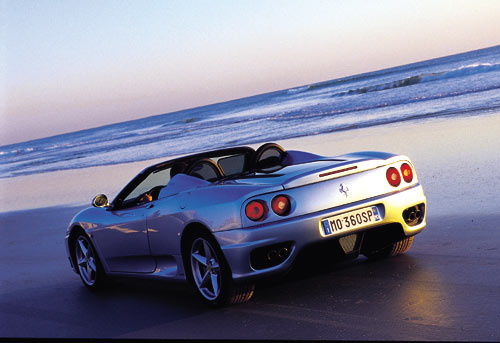
|
I know it's stating the obvious, but
it has to be said - this car is truly stunning. Including racing cars and individual models for customers, the 360 is the
163rd Ferrari designed by Pininfarina and happily, in the metal, has a undeniable beauty that early photographs hardly hinted
at. The Ferrari looks like it could fly to the moon if its oxygen and fuel tanks were topped up. Its styling is ultra-modern
and ultra-sharp. And it drives exactly as it looks. No road car can match the sheer instant response of the 360's fly-by-wire
electronic throttle. As soon as the pedal is touched, the car leaps forward and hurtles right up to the 8,500rpm red line
with the high pitched scream of a race car. A conventional gearbox is no match for the Ferrari's six-speed F1-style electronic
paddle shift. Pulling the right-hand paddle forward shifts the gearbox up, while pulling the left-hand one changes it down.
The 360's brakes are excellent too, with sharpness and immediate bite.
| Ferrari 360 Modena Spider 3.6 V8 |

|
The 360 has an expensive and exotic chassis,
using an aluminium spaceframe, aluminium double wishbones and electronic damping. As with it's engine, gearbox and brakes,
the responses from it's steering and chassis are absolutely instant and totally true. Turn in sharp to a corner or hit a big
bump and the front of the Ferrari seems to stay absolutely level. The Ferrari's body and spaceframe chassis move as one single
piece and the Ferrari's turn into corners feels honed to perfection, with not a millimetre of play in the system. With the
traction control turned on, all potential oversteer in the 360 - on the road, at least - is killed before it even had a chance
to happen. With it switched off, the Ferrari with it's rapid power delivery is more prone to snapping out of line. The Modena's
cockpit reflects it's exterior and overall character with it's High-Tec instruments and aluminium trim as a state-of-the-art
supercar. All modern Ferrari's are designed to serve as proper long distance machines and with a deep stowage area under the
front bonnet and a small space behind the seat, the 360 is no exception to this rule.
| Ferrari 360 Modena Spider 3.6 V8 |

|
The 360 Spider adopts exactly the same mechanicals
as the berlinetta: a mid-rear mounted 3,586 cc V8 delivering 400 bhp at 8,500 rpm with a longitudinal gearbox incorporating
the limited slip differential. What that means in practice - on the road and on the test track - is that the 360 Spider offers
almost identical performance and handling. In fact, open or closed, the car achieves a top speed of over 290 km/h, while weighing
barely 132 lbs more than the berlinetta and offering the same amount of room for the occupants and their luggage. The designers
of the 360 Spider worked hard to make the convertible version as aerodynamically efficient as its berlinetta counterpart.
This has been achieved using the twin radiators to help channel the airflow along the underbody to the extractors under the
tail. Despite the absence of any spoiler or wings, wind tunnel research has produced a negative lift figure and aerodynamic
downforce of 374lbs, compared to the 396lbs generated by the berlinetta. In order to achieve that downforce, the engineers
incorporated a nolder (a protuberance on the edge of the tail), a solution first adopted on Formula 1 cars. Compared to the
coupé's drag figure of 0.33, the Spider achieves a Cd of 0.36 - a figure which is the norm for open cars. Aerodynamic analysis
also extended to the fluid dynamics inside the engine bay. In fact the only apertures on the bonnet are the two grilles flanking
the glass cover. These share the same honeycomb pattern as on the berlinetta, though the size of the hexagonal openings has
been increased to ensure the correct amount of heat can escape from the Spider's slightly smaller engine bay.
| Eagle E-Type 4.2 Roadster |
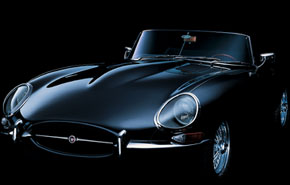
|
The Jaguar E-Type is the most exciting car ever
made. That is a strong statement, but consider the following:
In it's day it was extremely fast.
It offered killer styling.
It featured advanced technology.
It held its own with high dollar exotics, yet
the price was reasonable.
Many say that no car before or since can equal
the E-Type. Those who make the claim do not often get an argument; in automobile enthusiast circles, Jaguar's E-Type rules.
The most special of Coventry Cat's possessed a flair, speed, charisma and soul that we may never see again. The Jaguar E-Type
did not instantly achieve its place in automotive history. It's roots are directly related to racing. In the 1950s, the C
Type ("C" for competition) took first place in 1953 at LeMans with Duncan Hamilton and Tony Rolt driving. Pressure from other
teams forced Jaguar to build a more competitive model, and the D-Type was born. Rather than a tube frame chassis, the D-Type
consisted of a stressed monocoque behind the engine with a space frame in the engine area; the E-Type would feature the same
configuration. Another big improvement was in the brakes, with drums being replaced by discs at all four corners, another
tradition that the E-Type would benefit from.
| Jaguar E-Type 4.2 Series I Roadster |
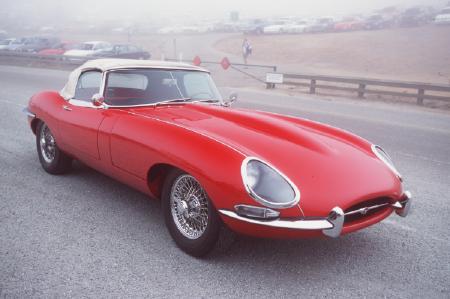
|
Jaguar E-Type
3.8-litre 1961-1964
In March 1961 Jaguar showed the E-Type at the car-show in Geneva. Although this car
showed great resemblance to the D-Type sports car of the fifties, this car was the result of the most modern technologies,
which made one of the top sports cars. The E-Type was undoubtedly the most streamlined production-vehicle for sale in that
time. From the beginning the E-Type was available in 2 versions. A two-seater roadster with a detachable roof, side windows
which could be turned down, a nice boot and the option to convert it to a Grand Touring Coup/e using a fiberglass hardtop.
The alternative was a two-seater Fixed Head Coupe with a fastback rear containing a boot, which opened to the side. Mechanically
the E-Type had little to do with its predecessor the XK150, but it did have the XK six-cylinder engine. In only one version:
with three SU-carburettors from the S-version that was good for a 265bhp at 5500rpm. To limit the height of the engine there
was a separate tank between the radiator and the engine and the thermostat-controlled electrical cooling fan replaced the
old engine-driven fan. The transmission also came from the CK, it was the four-speed Moss gearbox without an overdrive. For
the rear of the car Jaguar had developed something special which would be used until the 90's in almost the same shape: a
complete backside in a separate sub-frame. It had a Salisbury differential from a type that resembled the one from the other
jaguars; it had a Power-Lock anti-skid and it was star assembled in the steel sub-frame. The whole rear-unit was mounted to
the rest of the frame with four encapsulated mountings made from rubber to damp the sound and with two reaction-arms that
were also made from rubber. It also had a stabilisation-rod. Between the sub-frame and the bodywork there was no contact between
metal parts. The performance was improved slightly in comparison to the XK150 3.8 S with acceleration from 0 to 80 (km/h)
in 5.6 seconds (more than half a second faster) and a top-speed of 240 km/h. The 3.8-litre E-Type was produced at full capacity
until in 1964 the model was upgraded with the Mark X.
| Jaguar E-Type 4.2 Series I Roadster |
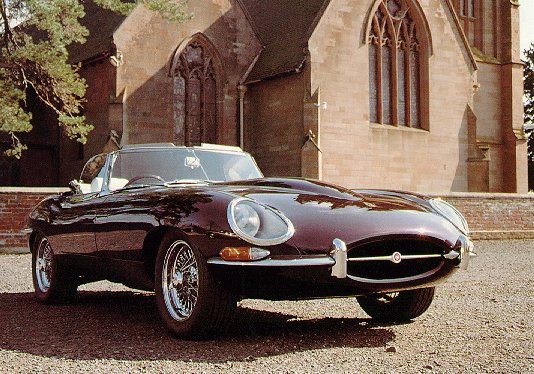
|
Jaguar E-Type
series 1½ 1967-1968
Jaguar offered a transition-model in the E-Type model-range; a half developed Series
2 from 1968. From 1967 the semi-officially called Series 1½ was for sale. It already had some of the characteristic features
of the Series 2. It is not possible to give many specifications of this model because the early and late models differ a lot
from each other. Most of them do have uncovered headlights. Apart from this change the car still had the bonnet and bumpers
of the Series 1.
Jaguar E-Type
series 2 1968-1970
The Series 2 E-Type was first showed in October 1968 at the Motor Show of Earls Court.
Many exterior changes had been fitted to comply with the more and more complicated American Laws. A brand-new bonnet
with a larger capacity air-intake that offered 68-procent more capacity was fitted. This supplied better cooling for the new
emission-demands adapted XK-engine. The new bonnet had built-in headlights which were placed 5 cm to the front and which were
completely uncovered. More chrome was used; there were new bumpers that ran across the full width of the car. The 4.2-Litre
XK-engine was adapted for the more strict American emission-demands for exported cars. To increase cooling-capacity, two electrical
driven fans were mounted. The Series 2 kept its three SU-carburettors for the home-market. Four America 2 Stromberg C-carburettors
were mounted with an adapted manifold. The car's performance decreased drastically. The brakes got a larger break-area and
three brake-pistons were mounted at the front and rear. According to Jaguar production of the Series 2 stopped in September
1970, which meant a brake in the production of E-Types because the Series 3 was first introduced in 1971.
| Jaguar E-Type Series II Roadster |
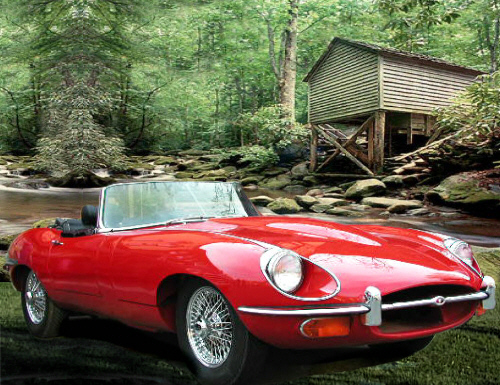
|
E-Type
series 3 1971-1975
The last development of the E-Type came on March 29, 1971. The brake in production of
the E-Type had 2 reasons. First of all Jaguar had to sell the Series 2 that were still in stock because of decreasing sales-numbers.
Secondly development of the Series 3 took longer than expected. But when the Series 3 was finally released it brought the
E-Type back at the top of the section-section. Jaguar had already built a 5-litre twelve-cylinder engine with 500 bhp for
the XJ13 prototype racecar and was found suitable for the next generation E-Types, but the complexity would result in some
difficulties with the production. That is why Jaguar invested 3 million pounds in the development of a new V12-engine and
the production-facilities for this engine. The new engine was not only meant for the E-Type, but also for the XJ6. The new
engine offered 272bhp at 5850rpm. With these new specifications the car had much more muscles than its predecessor. The acceleration
from 0-100km/h of the old hand-shifted 3.8-litre was 7.1 seconds in comparison to the 6.4 seconds of the V12. The Series 3
was available with the Borg Warner Model 12 three step automatic or with the fully synchronised Jaguar four-speed gearbox.
The front sub frame of the E-Type had to be adapted to be able to handle the weight and violence of the V12 engine. This also
meant that the front impact-plate had to become firmer as well as the mounting of the front connection rod. The newly designed
bonnet had wider front-shields and wheel housings due to the wider tyres and wheels. It also had a larger air-intake with
a chromed grill to be able to cool the immense V12. The headlights were uncovered, although they were slightly different from
the Series 2. The new cars had the doorframes of the 2+2 and the rear-wheel-housings where deeper because of the wheels. The
rear-unit had also been changed, and most striking were the four exhausts, which were really flat. Due to decreasing sales
in 1975 Jaguar decided to stop production of the E-Type. The retirement of the E-Type meant the end of Jaguar Sports-car production
for a long period. Since then the Series 3 have probably become the most wanted E-Types, especially the Roadster. It was a
Jaguar E-Type V12 Roadster that broke the £100,000 record during the classic-car hype of the late 80's.
| Jaguar E-Type 3.8 Series II Roadster |
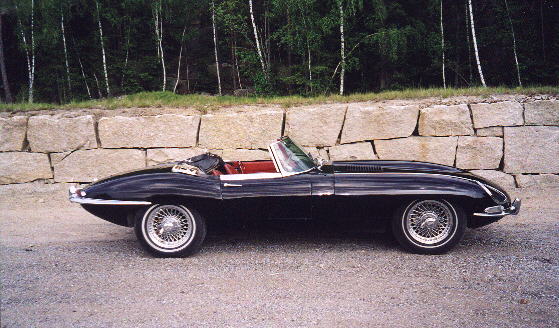
|
The words 'Jaguar E-Type' quite simply amount
to 'Legend' The Jaguar E-Type was once described by Enzo Ferrari (The founder of Ferrari) as the most beautiful car he had
ever seen, anywhere, ever. This coming from the man who created some of the most amazing machines on the planet. Enzo
went on to congratulate the design team on their efforts, and hailed the E-Type as the best car in the world. The E-Type is
a mix of race-bred 'supercar' and grand tourer. It does everything and more importantly, it does everything right. It just
looks right, sleek, long nosed, short-tailed, just fantastic to look at. Jaguar did everything they could to the best of their
ablility and the end result was one of pure excellence. It's the icon of the sixties and beyond, and it has just celebrated
it's 40th Birthday. And the best bit, well the best bit I have left until last. The best bit about the Jaguar E-Type is, it's
British.
| Aston Martin V12 Vanquish 6.0 |
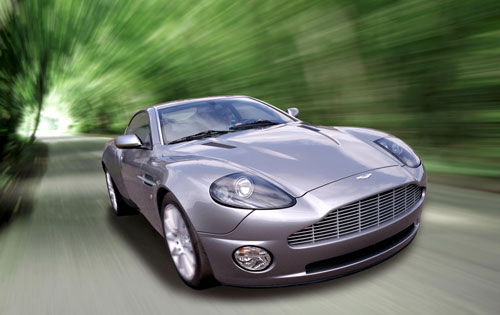
|
VANQUISH - 'to reduce to submission
by superior force', in other words to conquer, overpower or overwhelm.
The positive reception received by the Project
Vantage was huge. Customers, enthusiasts and the press urged Aston Martin to make the concept car a reality - and so it came
to pass. After building 70 prototypes, the V12 Vanquish was unveiled to the press in October 2000, although the public had
to wait until the Geneva Salon in March 2001 to see the final production car in the flesh. Designed by Ian Callum, who also
was responsible for the DB7, the V12 Vanquish is extremely faithful to the Project Vantage. It's 6.0 litre V12 engine has
been developed from that already available in the DB7 Vantage with new design inlet manifolds, camshafts, valve gear, crankshaft
and exhaust system. Power is up to 460bhp giving a top speed of 190mph and acceleration to 60mph in 4.7 seconds. The six speed
manual transmission is linked to the electronic drive-by-wire throttle and controlled through F1 style twin paddles mounted
on the steering column. Developed in conjunction with Magnetti-Marelli and Ford RVT, the advanced paddle shift gear change
incorporates electronics matched to hydraulics which enable almost imperceptible gear changes in just 250 milliseconds. The
delay in the launch of the V12 Vanquish was believed to be caused by Aston Martin Chief Executive, Dr Ulrich Bez and his insistence
on a higher quality interior than initially planned. Whilst eight Connolly hides are still needed, the wood trim has
been banished from the car. Unusually, the car can be specified as a two seater with load space or, for an additional £5000,
as a 2+2, although the rear seats are nothing like as large as those in a V8.
| Aston Martin V12 Vanquish 6.0 |
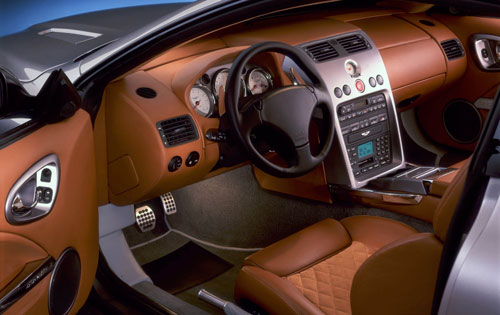
|
The V12 Vanquish is not only the
most advanced Aston Martin of all time - it is a quantum leap from the previous V8. The main body structure is formed from
extruded aluminum sections bonded and riveted around the central transmission tunnel which is constructed entirely from carbon
fibre. All the exterior panels are produced from 'super-formed' aluminum, tailored and bonded to the central structure by
hand for a perfect fit. Initial demand for the £158,000 V12 Vanquish has been astonishing - Aston Martin now claim that the
next three years production may already have been sold (planned production is expected to be about 300 per year). Newport
Pagnell, the Aston Martin factory is a hive of activity. The majority of the cars appear to be silver although
I have seen one in green (very nice) and also a single black example. It's hard to believe that this
stunning car you see before you is a Ford product. Yes, Ford, the Blue Oval monolith responsible for producing smelly heaps
such as the Scorpio and the Mustang II. But here it is, a limited-production £158,000 supercar capable of standing toe-to-toe
with greats like the Porsche 911 Turbo, Ferrari 550 Maranello and Lamborghini Diablo. But the V12 Vanquish is also
a rolling test-bed of advanced technology and manufacturing techniques that Ford couldn't try out on anything other than a
premium vehicle. The result is a lightweight, extremely stiff body and chassis.
| Aston Martin V12 Vanquish 6.0 |

|
The traditional Aston Martin styling cues are
there, such as the trademark grille and side vents, but the design isn't sleek like a DB7's. It's more brutish. Under the bonnet
is an updated version of the V12 found in the DB7 Vantage. This 6.0-litre 48-valve engine makes 460bhp at 6,500 rpm and 400lb
/ ft of torque at 5,000 rpm. The clutchless six-speed close-ratio manual gearbox is controlled through twin paddles mounted
on the steering column. Similar to the system in the Ferrari 360 Modena, the advanced paddle shift transmission incorporates
electronics matched to hydraulics to facilitate nearly instantaneous gear changes. Sophisticated electronics also permit automatic
operation with the additional facility of a program for winter driving conditions. Aston Martin says the V12 Vanquish will
accelerate from 0 to 60 mph in 4.5 seconds and top out at 190 mph. Owners of the new Aston Martin V12 Vanquish are invited
to Newport Pagnell in advance of production to select the body colour, the Connolly hide upholstery scheme and either the
two-plus-zero or two-plus-two seat configuration. A deep center console unit separates the driver and front passenger seats
and incorporates a red engine starter button, the sound system and the climate control system. The overall interior design
is a subtle blend of traditional, classic and modern materials with Connolly hide upholstery matched to contemporary metal
interior fittings and finishes. Should you have £158,000 and superb connections, you might just be able to buy one.
| Aston Martin V12 Vanquish 6.0 |
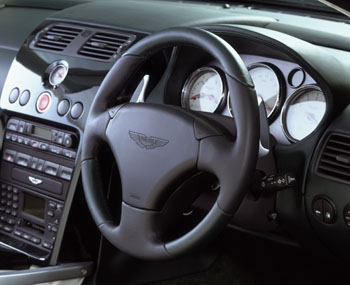
|
Aston people never mention Ferrari, preferring
the Vanquish to be seen as a modern, high-tech successor to its archaic "V" cars big, heavy, handcrafted models that could
trace a lineage back to the race-bred Astons of the 1960s. But the truth is the Vanquish has only one direct competitor in
its exalted price class, and that is the Ferrari 550 Maranello. In 1996, Ferrari, which is owned by Fiat, shocked supercar
fans by introducing the 550 model as a front-engined two-seater. For a quarter of a century its roadgoing flagships had followed
racing practice by putting the engine behind the driver. Now Ferrari, it seemed, was picking up where the 365GTB/4 Daytona
left off in 1971. Ferrari president Luca di Montezemolo said that owners of it's 12-cylinder models were fed up with a reclining
seating position behind a steeply inclined windshield, poor visibility, and a lack of luggage space. The 550, it was noted,
would be faster, easier, and more practical to use and have better handling at its limits than the mid-engined F512M that
it replaced. And so it was. Surprisingly few mourned the passing of the Testarossa/512. And anyway, today's smaller and lighter
mid-engined 360 Modena is almost as fast. The 550 Maranello became the new benchmark for the grown-up exotics and lots of
car magazines proved it's serious performance with a series of production-car speed records, including an average of 190.132
mph over a 100-mile distance.
| Aston Martin V12 Vanquish 6.0 |
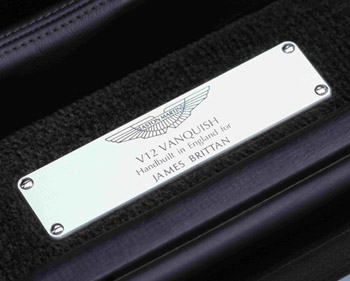
|
The Aston Martin V12 Vanquish can be personalised
in many different ways. These include having the central dash changed from aluminium to the exact body colour of the car.
This is shown in the second interior shot above. You can also have the steel plates that sit on the bottom of the door sil
engraved with a title or a personal message. The other options range from a battery conditioner (to keep the battery in good
working order through the winter months) to a 300 watt premium sound system. The Aston Martin V12 Vanquish is set to appear
in the latest James Bond film 'Die another day' (out in November) so if it's good enough for Bond, i'm sure it's good enough
for everyone else. The Vanquish really is the ultimate symbol of stlye and sophistication.
| Mercedes SL55 AMG |

|
After 12 years and more than 200,000 sales in
the luxury roadster market, Mercedes old flagship SL has finally been put out to grass. But taking over where it left off
is this, the fifth-generation car. And if the admiring stares it encountered at this years motorshows are anything to go by,
it's set to become the most successful incarnation yet. The overall shape with its impossibly long bonnet and forward-sloping
flanks, draws heavily on the family lineage - inparticular the original 300SL of 1954. But this is no retro throwback. Cars
of this size can rarely be described as elegant, yet the SL's beautifully detailed body and finely crafted rear end could
rival a Roman statue for visual drama. This seemles blend of classic styling and cutting edge technology is at the very core
of the cars immense desirability. Where converting the old SL from hard top to roadster required the assistance of two burly
friends and a sizable space in the garage (due to the removed metal roof) the new machines metal Vario roof can be folded
into the boot at the flick of a switch. In a masterful display of engineering and design execution, the panels fold back,
the rear window tilts 180degrees and the whole assembly glides under the rear deck. The whole sequence takes around 17 seconds,
which is just enough time for onlookers to experience every emotion, from amazement to admiration to pure, unadulterated jealousy.
| Mercedes SL55 AMG |

|
Mercedes has a long tradition of building solid,
ergonomically corect interiors, but style has never been the three-pointed star's forte - until now. The new SL has a cabin
to match the bodywork. With large multi-adjustable leather-trimmed electric seats and a near-faultless driving position, the
emphasis remains primarily on comfort. But the sculpted dashboard and striking instrument binnacle are a revalation. The SL
is no longer a four-seater, and Mercedes has elected to use the freed-up room to boost the SL's grand touring credentials.
The rear seats have been replaced by useful lockers and retaining straps, while there is a generous 317 litres of luggage
space (or 235 litres with the roof down). An 80-litre petrol tank helps counteract the thirst for fuel - most tests averaged
18.0mpg. Nevertheless, the SL slips easily into the role of continent-crushing cruiser. It's also indecently fast. With 306bhp
and a whopping 460Nm of torque at 2,700rpm, the SL500's 5.0-litre V8 is a gem. It's smooth, flexible and blessed with a tantalisingly
deep, bass-laden soundtrack, it's capable of pushing the 1,845kg roadster from 0-60mph in only 5.5 seconds and on to a limited
top speed of 155mph. Mated to this is a five-speed automatic transmission that's slick and responsive.
| Mercedes SL55 AMG |

|
Laid-back limousine, refined grand tourer, taut,
focused sports car - the German two seater does it all, and to a degree of excellence that edges it frighteningly close
to perfection. The active body control (ABC) wafts the SL along as if it were floating on a pillow of air.
Which, in effect, it is. The newcomer uses an adapted and uprated version of the S-Class's gas-filled damper set-up,
which offers unparalleled ride comfort in it's standard setting and levels of grip and mid-bend composure in sport mode that
simply defy description. Add sensonic brake-by-wire technology that improves reaction times and eradicates ABS 'pulsing',
and the SL is nothing short of a technological tour de force. For the time being, the £67,790 SL500 is the only model available. And
while that's undoubtedly expensive, a glance at the spec table shows exactly how well equipped the roadster is - not
a pound sign in sight, the SL comes with everything as standard. Running costs will be steep, but the fact that
the waiting list is already more than 3 years long shows precisely how much demand there is for this car - and that will
help residuals stay high. Factor in the SL's breathtaking engineering and sheer feelgood factor, wrapped up in such a stunning
body, and I defy you not to be tempted.
| Mercedes SL55 AMG |

|
Of all the technical milestones on display, it
is Sensotronic Brake Control (SBC) the electro-hydraulic braking system that leads the way. Mercedes-Benz is the first automobile
brand in the world to offer this system. SBC works together with ESP® the proven electronic stability program and with Active
Body Control (ABC) suspension. The latter reduces body roll to a minimum when cornering or braking. All of which means that
the new SL-Class comes with a unique package of high-performance electronic control systems fitted as standard. These innovations
revolutionise chassis design, active safety and drive dynamics. And, in the medium term, they may well change the entire concept
of automotive development. Sensotronic Brake Control pushes open the door to the future world of "by-wire" systems. This technology
communicates the driver's commands electronically via cable, rather than mechanically or hydraulically, as has traditionally
been the case. Among the foremost performance characteristics of SBC are the extremely fast build-up of pressure and the precise
observance of driver and vehicle behaviour by a complex sensory system. If the driver switches his foot quickly from accelerator
to brake pedal, SBC recognises the early signs of an emergency situation. With the help of the high-pressure reservoir, the
system automatically raises the pressure in the brake lines and instantaneously presses the pads onto the brake discs, which
can then spring into action with full force as soon as the brake pedal is pressed. This system can reduce emergency stopping
distances by up to three percent. Furthermore, variable brake force distribution means SBC can provide increased safety when
braking around corners. And, thanks to its greater speed and precision, it also enhances the performance of the Brake Assist
and the ESP® electronic stability program.
| Mercedes SL500 |
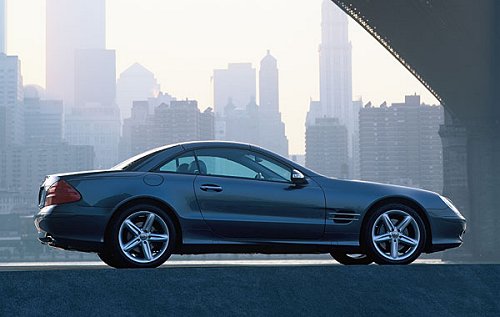
|
Thanks to an integral vehicle safety concept,
the SL-Class is on course to set the standard for a whole new generation of sports cars. The concept encompasses every aspect
of vehicle safety from crash avoidance by means of electronic safety systems such as SBC, ABC, Brake Assist or ESP®, and the
high-strength body structure, to the fastest possible rescue of the car's occupants in the event of an accident.Occupant protection
is optimised by the high-strength body structure and, among other things, two-stage airbags for the driver and passenger,
new head-thorax bags in the doors, new integral seats, seat belt tensioners, belt force limiters and the sensor-controlled
roll-over bar. The computer in the optional DISTRONIC cruise and proximity control is one of the fastest and most powerful
microcomputers on board the new SL-Class and, indeed, in the entire automotive industry: the digital signal processor (DSP)
clocks at 40 megahertz. With lightning speed, it processes the signals from a radar sensor which is mounted in the radiator
grille to monitor the traffic conditions up to 150 metres in front of the sports car. The sensor's three transmission and
receiver units have an acceptance angle of three degrees and, from about 100 metres away, scan the entire width of a three-lane
motorway, detecting any cars in front. They reflect the short-wave radar pulses (77 gigahertz), the signal delay forming the
basis for the distance calculation and simultaneous frequency change (Doppler effect) being used to determine the relative
speed between the vehicles. If the SL gets too close to the rear bumper of another car, DISTRONIC automatically eases off
on the throttle or, if necessary, activates the brake to maintain the desired distance. If the gap between the two vehicles
starts to increase again, the system re-accelerates the sports car to the originally set speed or re-establishes the desired
distance. DISTRONIC brakes the SL, reducing the speed by up to two metres per seconds squared, equivalent to about one fifth
of the maximum possible deceleration. If the microcomputer calculates that faster deceleration is required, it informs the
driver by activating a warning light on the instrument cluster and sending an audible signal. The driver must then press the
brake pedal. DaimlerChrysler research has shown that DISTRONIC makes motoring more comfortable, relieves stress and gives
a whole new, relaxed feeling to driving. And one last thing: once activated, the proximity control kicks in as soon as the
speed reaches 30 km/h. And even when switched off, the DISTRONIC system can warn the driver if the SL is approaching a car
ahead too quickly or if it is too close to the car in front. The legend is well and truly alive. And the "SL" badge remains
the mark of an automobile which, besides perfect technology, embodies two characteristic quality features above all: excitement
and passion. The SL is the worlds finest roadster and sets new class standards.
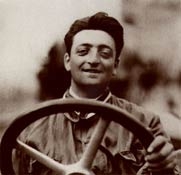
|

|

|

